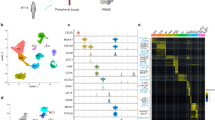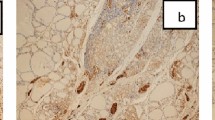Abstract
THE cells referred to in this communication were called parafollicular cells by Nonidez1 in dog thyroid. The name was afterwards transferred to cells staining in a similar manner in other species, irrespective of their anatomical position. It was condemned by Stux et al.2 as inaccurate. They substituted the name light cell because, in rat thyroid, the cells are not stained by the periodic acid–Schiff (PAS) method by comparison with the colloid granules of the acinar cells. The name C cell3 was intended to refer to their responsibility for calcitonin secretion, as indicated by cytochemical tests and by immunofluorescence4. It avoids reference to the staining qualities of the cells and to their precise localization, and for this reason it can be applied to all species and to organs and tissues other than the thyroid. Not only are the cells not parafollicular, they are not confined to the thyroid5 and in some species are probably mainly extra-thyroid.
This is a preview of subscription content, access via your institution
Access options
Subscribe to this journal
Receive 51 print issues and online access
$199.00 per year
only $3.90 per issue
Buy this article
- Purchase on Springer Link
- Instant access to full article PDF
Prices may be subject to local taxes which are calculated during checkout
Similar content being viewed by others
References
Nonidez, J. F., Amer. J. Anat., 49, 479 (1931–32).
Stux, M., Thompson, B., Isler, H., and Leblond, C. P., Endocrinology, 68, 292 (1961).
Pearse, A. G. E., Proc. Roy. Soc., B, 164, 478 (1966).
Bussolati, G., and Pearse, A. G. E., J. Endocrinol., 37, 205 (1967).
Carvalheira, A. F., and Pearse, A. G. E., Histochemie, 8, 175 (1967).
Ritzen, M., Hammarström, L., and Ullberg, S., Biochem. Pharmacol., 14, 313 (1965).
Gershon, M. D., and Ross, L. L., J. Physiol., 186, 477 (1966).
Pearse, A. G. E., Nature, 211, 598 (1966).
Pearse, A. G. E., Vet. Rec., 79, 597 (1966).
Eränkö, O., Acta Anat., 16, Suppl. 17 (1952).
Falck, B., Acta Physiol. Scand., 56, Suppl. 197 (1962).
Pearse, A. G. E., and Ocumpaugh, D. E., Proc. Roy. Micros. Soc., 1, 137 (1966).
Larson, B., Owman, C., and Sundler, F., Endocrinology, 78, 1109 (1966).
Rogers, W. H., Amer. J. Anat., 38, 349 (1927).
Klapper, C. E., Amer. J. Anat., 78, 139 (1946).
Dudley, J., Amer. J. Anat., 71, 65 (1942).
Maurer, F., Morph. Jahrb., 13, 296 (1888).
Born, G., Arch. f. Mikros. Anat., 22, 271 (1883).
Kastchenko, N., Arch. f. Mikros. Anat., 39, 1 (1887).
Zuckerkandl, E., Anat. Hefte, 21, 1 (1903).
Weller, G. L., Carnegie Inst. Wash. Publ. 493 Contrib. Embryol., 24, 93 (1933).
Norris, E. H., Carnegie Inst. Wash. Publ. 479, Contrib. Embryol., 26, 247 (1937).
Godwin, M. C., Amer. J. Anat., 60, 299 (1937).
Tashiro, M., Nagoya, J. Med. Sci., 25, 159 (1963).
Sehe, C. T., Endocrinology, 67, 674 (1960).
Saxén, L., and Toinoven, S., J. Embryol. Exp. Morphol., 3, 376 (1955).
Gorbman, A., Anat. Rec., 98, 93 (1947).
Author information
Authors and Affiliations
Rights and permissions
About this article
Cite this article
PEARSE, A., CARVALHEIRA, A. Cytochemical Evidence for an Ultimobranchial Origin of Rodent Thyroid C Cells. Nature 214, 929–930 (1967). https://doi.org/10.1038/214929a0
Received:
Revised:
Issue Date:
DOI: https://doi.org/10.1038/214929a0
This article is cited by
-
La calcitonina: prime evidenze di un ormone del futuro
L'Endocrinologo (2022)
-
Neuroendocrine Tumors of the Thyroid and Their Mimics
Endocrine Pathology (2021)
-
C and APUD Cells and Endocrine Tumours. Pearse’s Laboratory in the Years 1965–1969: A Personal Recollection
Endocrine Pathology (2014)
-
Review: The Role of Neural Crest Cells in the Endocrine System
Endocrine Pathology (2009)
-
Sinus-piriformis-Fistel als seltene Ursache von Dyspnoe bei einem Neugeborenen
HNO (2008)
Comments
By submitting a comment you agree to abide by our Terms and Community Guidelines. If you find something abusive or that does not comply with our terms or guidelines please flag it as inappropriate.



